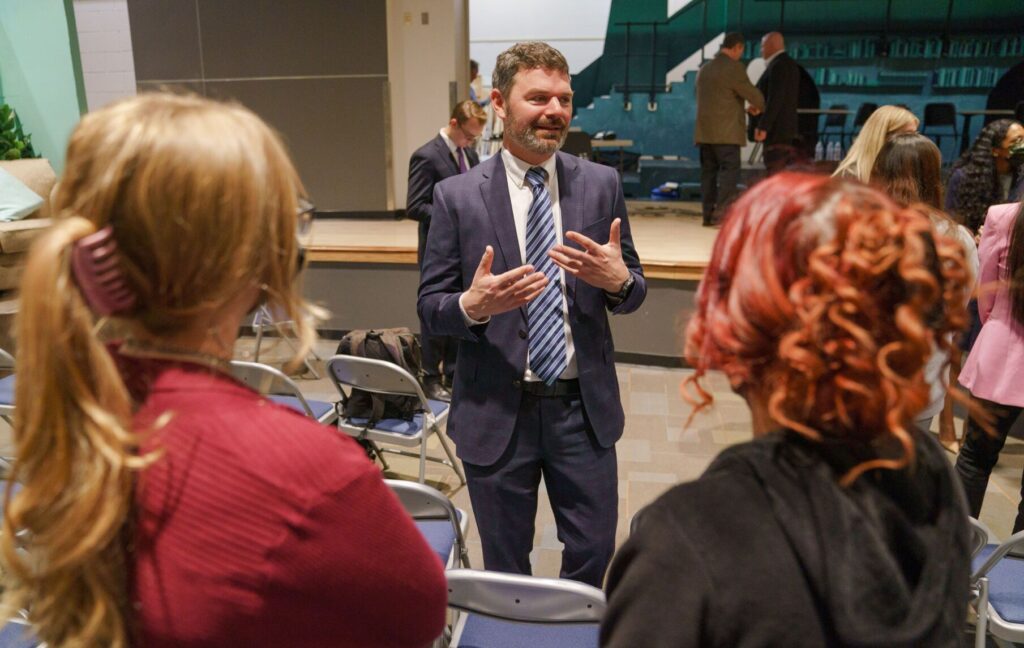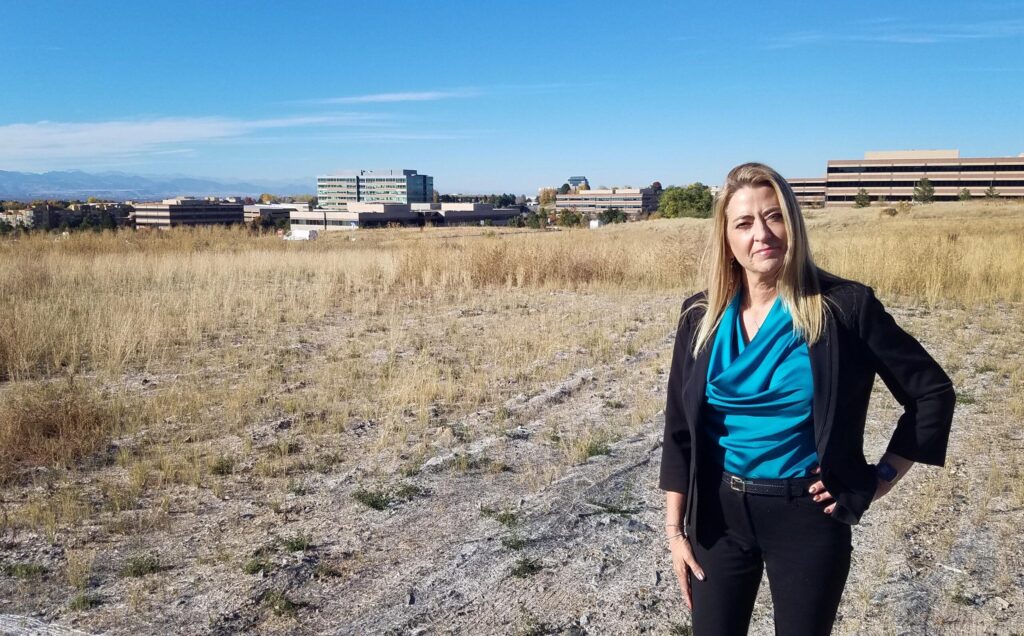BEST OF COPO 2018 | What worries rural Colorado?

Colorado Politics is taking a look back at some of our most significant and compelling stories of 2018. This story originally was published Sept. 28.
It’s a Tuesday morning at the La Jara Trading Post, in the San Luis Valley a few miles north of the Colorado-New Mexico state line. The employees and a steady stream of customers are talking about the Denver Broncos’ season. But it’s not the only topic they’re musing about on this warm September morning.
A couple days earlier, the father-in-law of one of the store employees found his home had been broken into. The thief was caught the same day, and it turned out to be a former employee of the Trading Post who they say has a drug problem.
It’s that drug problem that plagues too many in this town of just under 800 residents. Talk to Sabrina Husmann, one of the co-owners of the trading post. While residents say their community needs jobs, Husmann has had a position open for five months that she can’t fill because she can’t find someone who can pass a drug test. The trading post, an ACE Hardware affiliate, requires drug testing because of the heavy equipment that employees operate.
Colorado Politics traveled close to 2,000 miles along the backroads of rural Colorado during September, talking to residents and business owners about the elections (they aren’t paying that much attention, although they don’t like the negative ads); whether they’ll vote (most said yes) and what issues are important to their communities.
The latter question drew an earful, and from Lamar to Montrose to Parachute to Silverthorne, people said drugs, both legal and illegal, are giving these communities a headache.
Residents in Lamar talk about drug needles found in the park located adjacent to the Colorado Welcome Center. Needles in the parks are a problem in Montrose, too, say people there.
That’s the heroin and meth side. But recreational marijuana, even though legal under Colorado law, is creating its own set of problems, according to residents in some of the towns that allow its sale.
Drugs in rural Colorado rest on the top of an iceberg of other issues such as employment and homelessness.
Residents of rural communities also say lawmakers and political leaders don’t pay enough attention to rural Colorado, and that the rural-urban divide is alive and well.
Drugs loom large
In almost every community Colorado Politics visited in September, drugs were either the No. 1 or No. 2 issue raised by residents when asked what they would tell the next governor should he visit their towns.
This issue is far more personal to rural Coloradans than it is for those who live in the state’s largest cities. Husmann said that’s because those with drug problems are their neighbors, friends or relatives.
“Drugs are more in your face than you’d think,” she said. “It’s everywhere you go. There isn’t a week that goes by where someone comes in and tells me” that someone else has been robbed.
Several employees of Husmann’s business commented that sometimes they’re afraid to go to work because they fear they’ll find their homes broken into at the end of the day.
Not far from La Jara, Donald Chavez owns Chavez Southwest Market & Antiques in Antonito, as far south as you can get in Colorado without being in New Mexico. The town is at the northern end of the historic Cumbres & Toltec Scenic Railroad. It also has a recreational marijuana dispensary on the town’s south end, one of three in this community of 756.
Chavez, who can trace his family’s roots in the San Luis Valley to 1510, owns a store that’s a catch-all: groceries, antiques, jewelry, a few farm supplies. Drugs – heroin, meth, opioids – are rampant in Antonito, he said. People steal from their neighbors and then come into his store to pawn the ill-gotten goods, which he says he refuses.
At the other end of the state, in Grand County, Dee Kitchen landed in Hot Sulphur Springs 24 years ago, stranded with her three kids by her now-ex-husband. She started off working in a local restaurant and living in a motel. Without a car, she hitchhiked to Grand Lake for groceries.
But things got better, and she’s now buying the motel and becoming a first-time business owner. It’s given her a perspective on issues like homelessness and affordable housing few can share.
There are more transients in the area that there used to be, Kitchen said. She believes drugs are at least partially responsible, and said the community has no resources for dealing with the problem.
Pot brings problems
While rural Coloradans have illegal drugs on their minds, they also are concerned about a legal one – recreational marijuana.
Lena Meredith, who owns the USC Inc. employment agency in Delta, has 60 job openings in Delta County. “We have a lot of great employers around here and we can’t fill the jobs,” she said.
The reason? No one can pass a drug test – and it’s marijuana that’s flunking them out, she said. Many of the jobs require work with heavy machinery.
“It’s dangerous to be on it,” she said. “You don’t react quickly enough. … Lives are at stake.”
Down the road from Delta in Olathe, you’ll find Pamela Friend at the Friendly Farmer’s Market just outside of town, where Pamela and her husband sell their locally-grown tomatoes, chiles, squash, potatoes, onions, beans, peppers, okra, herbs and of course, the famous Olathe sweet corn.
She’s a third-generation farmer. “You carry on the family tradition and business, and this is where it started,” she said. They also own a drive-in theater in Montrose.
It’s that drive-in that gives Friend the most headaches, although the lack of water for farming and low commodity prices are also causing her grief. She said her accountant at the drive-in asks her regularly how many employees last more than two weeks. The answer is almost always “none.”
“One of the biggest mistakes Colorado ever made is legalizing pot. All of the teenagers use it,” she said.
Back in Antonito, Chavez said that if there’s big money coming to town through marijuana taxes, the people there have yet to see it. But he also pointed to black-market marijuana, which he indicated is flourishing in his part of the San Luis Valley. The town needs something else for the young people to do, he said.
Marijuana is also bringing the kinds of problems that some small towns have little experience with.
Jared Hawn is a flyfishing guide for Cutthroat Anglers in Silverthorne. In the last five years, marijuana has brought a “culture of panhandling” to Summit County, he said. He knows pot sales are good for jobs and the taxes are good for schools, but it’s brought people to the county who don’t want to work, despite “help wanted” signs everywhere.
Hawn said marijuana use – for those who visit the high-altitude area and can’t handle it – is also putting stress on emergency health services.
To the northwest, Colorado Northwestern Community College is one of the big economic drivers in Rangely, and it just hired a new assistant baseball coach, Josh Keil, who lived in Lakewood until August. He took the job at CNCC because it will give him a start in college coaching.
But there are other reasons: he’s sick of Denver traffic and happy to be rid of the influx of people who’ve moved to Colorado for legal marijuana. “It’s creating havoc,” he said.
His solution? Make it legal everywhere, not just in Colorado.
On the other hand, he’d like to see some of the taxes from marijuana put to work to support the state’s water needs.
Water’s a worry
Drugs aren’t the only issue facing small towns across the state, rural Coloradans say. Water came in second among the topics raised by those who spoke to Colorado Politics.
It’s not just water for irrigation for the crops that have just been harvested. Clean drinking water is not a way of life for many, particularly along U.S. 50 between Manzanola and Lamar in southeastern Colorado, say local people.
Sam Fosdick of Manzanola, who’s lived in the Lower Arkansas Valley for 60 years, said water quality has been a problem since the 1950s. Residents of the town, about 50 miles east of Pueblo, are pinning their hopes on a 130-mile pipeline from Pueblo Reservoir, a project being developed by the U.S. Bureau of Reclamation. That pipeline could provide clean drinking water to 40,000 residents who currently are dependent on well water that tinges their clothes red from the iron content.
You hear the word “conduit” a lot in this area, as well as “reverse osmosis,” a water purification system that is inexpensive and removes sediment, minerals and farm runoff from well water.
“The water quality is just not good without drastic treatment,” said Dale Leighty, the CEO of First National Bank of Las Animas, farther east on U.S. 50. “It’s a quality of life” issue, he added.
Lack of clean drinking water is also a problem in the San Luis Valley, where people also rely on wells. Chavez, who lives in Cañon, said he boils his water for drinking and cooking purposes because of its iron content.
Low water levels in Colorado’s rivers and reservoirs are making everyone nervous.
“We need rain!” said Leighty, who’s been in Las Animas for 36 years. He bemoans the flight of water from the Lower Arkansas River to municipalities on the Front Range: “When the water gets sold here, the land becomes nonproductive and that’s less families making a living in this corner of the state.”
The banker blames the dry-up of land in the Lower Arkansas, which he said started around 1986, as one of the reasons Las Animas’ main street has so many boarded-up buildings. “Just look around here,” he said, sadly.
The waters of Blue Mesa Reservoir in the Gunnison Valley feed agriculture as well as recreation and tourism businesses, and one owner says locals are really hurting because of the low levels at the reservoir, the state’s second largest.
Matthew de Wys has owned Blue Mesa Point, an RV and tent camping resort, for 15 years and has been coming to the reservoir for 40 years. The major source of income in the Gunnison Valley is tourism – fishing, hunting, boating, hiking – and it’s all dependent on water, he said.
“The Gunnison River is a creek,” de Wys said. “It’s the lowest I’ve ever seen.”
Most boaters who frequent the area have pulled their boats and aren’t even storing them at his resort anymore. De Wys said almost every resort from Montrose to Gunnison is up for sale, except for his.
At Cutthroat Anglers, Hawn, the flyfishing guide who’s been in Silverthorne for 30 years, talks about low water levels and the higher water temperatures that come with it. At 65 or 67 degrees, the business suspends its fishing services, and that meant less business in June and July. They fish rivers all over western Colorado, as far west as the Roaring Fork, as well as the Blue, Colorado and the middle fork of the South Platte.
“We dodged a lot of bullets this year” with the warm water, he said. But “we see more boats and anglers in conditions where they shouldn’t [fish],” which he said stresses the fish and the environment.
“Water should be a top priority [for the next governor],” Hawn said. “I know there’s a lot of issues – roads, congestion, I-70, marijuana – but without water there is no life.”
“If we don’t pray and get a heck of a winter, I don’t know what we’ll do,” said Friend, of Olathe. She had enough water to keep the crops irrigated, but none got enough for what she called “a good drink.”
Health care and housing challenges
Another issue that arose in many small towns are those faced by recent transplants to rural communities from Denver or Colorado Springs. Many say they came to the countryside to escape the traffic congestion and the high cost of housing in the cities they’ve left behind, but often they didn’t leave all their challenges behind.
Eleven months ago, Richard Taylor and his husband, Derrick, moved from Denver to Lamar, not far from the Colorado-Kansas line. They bought an RV park on the south end of town as an investment. The area “was our third choice,” he said, but after looking at the numbers, including projected growth in Colorado and the area’s history, they decided on Lamar.
The cost of living is much better than it is in Denver, he said. For example, in the next few weeks, they’re moving Derrick’s elderly parents from Golden to Lamar to assist in their care. Taylor pointed out they can buy a house in Lamar for less than half the cost of the home they’re selling in Golden, and the house in Lamar is twice the size.
That’s the good news. The struggle will be with health care – it’s “really bad here,” Taylor said, adding that the town has a part-time general practitioner but no full-time doctors and the nurses are traveling nurses because “there’s no incentive for them to stay here.”
And if a problem is serious, “they wrap you up and ship you off” to Colorado Springs, at a cost of about $20,000 for Flight for Life, he said.
Another issue: While housing is cheaper than in the big city, Lamar is short of places to live at a price that many local people can pay. There are virtually no rentals available in Lamar, Taylor said, so he gets calls several times a week from people who want to rent rooms at his RV park’s motel on a month-to-month basis. He would charge $1,500 a month for that, which he said might work in Denver but not in Lamar.
Affordable housing is an issue for mountain communities, too. Talk to Kitchen, in Hot Sulphur Springs, who said she’s seeing more people – the elderly, handicapped and low-income people – in need of affordable housing in mountain communities like hers. A low-income person can get a federal Housing Choice Voucher – formerly called a Section 8 voucher – to help them with housing costs, but there are few places in the area that accept them, she said.
Rents and home prices are also high on the Western Slope. Talk to Pamela Fancher and Shari Foster, who are grabbing an early lunch at Butch’s Cafe in Delta. They’ll tell you in one breath that the minimum wage is high enough, but not high enough for young people to make the rent.
Jobs, workers are concerns
While drugs and water came up in almost every conversation, many rural Coloradans also worry about jobs – not enough jobs in some cases; not enough workers available to fill them in others.
Friend, in Olathe, said she can’t find anyone to work on her farm. They last about two hours in the fields. She has the same problem at the drive-in in Montrose. It’s a simple job, she said, but nobody lasts more than two weeks. “I’m not sure our politicians can fix it, but it needs to be addressed. Nobody wants to work.”
John Hume has worked the oil fields, the Deserado coal mine and a local ranch in his 60-plus years in Rangely. The coal mine will always be here, he said, because the area power plant depends on it. “But we need to get diversified somewhere.” He sees recreation – cycling, four-wheeling and hunting – as one step to his town’s future. But there’s nothing to keep young people here, particularly jobs and businesses, Hume said.
Hume’s wife Beckey is busily painting a rental property on a Sunday morning. Her family has worked the oil and gas fields for years. She doesn’t like how demonized the industry has become – “people make it out to be so evil,” she said – and points out that there’s nothing that can replace those jobs. “We’re a fuel economy,” she explained. “No other industry is willing to come here.”
Chavez, of Antonito, said he sees lots of job possibilities in his town. He points to nearby forests that include beetle-kill pine that could be harvested. The area also has lots of possibilities for gypsum, biofuels and outdoor recreation like hunting, fishing and climbing in the nearby mountains. “You have to have some kind of industry. People are leaving because there’s nothing,” Chavez said.
Husmann, up the road in La Jara, agrees that young people don’t have enough job or recreational opportunities in the San Luis Valley. “It’s a good place to raise kids,” she said. “But my advice is that if you don’t have a family business, get out, go to school and do something else with your life” and maybe come back to the valley later.
Back east, Rod Coulter is a jack-of-all-trades of Las Animas. In addition to owning the local hardware store, he’s a pastor, rancher, farmer and a volunteer firefighter.
He’d like the next governor to take an interest in activities for the youth in his county. The job situation is “very tough” in Las Animas, with a lot of boarded-up buildings on the town’s main and side streets. “We do have the hog farms and they require a lot of people,” he said. And while he’d like to see more jobs in the county, “we’re doing pretty good here.”
For roads, ask Steve Bauserman, a farmer and one of the owners of Bauserman’s Farm Market in Manzanola, along U.S. 50 between Pueblo and Rocky Ford. He likes the idea of fixing roads and points to the two-lane highway outside his door, which he says should be widened to four lanes between Pueblo and Manzanola. It’s the heavy semi traffic that’s tearing up the road, he said.
The election: Is anyone listening?
Rural Coloradans also have their eyes on the election that’s just a few weeks off.
Nina Wood of Kremmling was in Parshall, on U.S. 40 in Grand County, to meet up with a friend. She’s very interested in the election (her brother is the Grand County GOP chair) and she’s especially watching amendments Y and Z , the state ballot measures that would set up a new system for redrawing congressional and legislative boundaries.
If Democratic candidate Jared Polis is elected governor, “he can go jump in a lake” she said, but added that it doesn’t really matter who’s running; they’re all politicians.
Bauserman of Manzonala said he is not a fan of the negative ads he’s seen and that most of his neighbors don’t like Polis.
In Lamar, “politics are huge down here; everyone talks politics,” said Taylor, the RV park owner. “I think we’re moving in the right direction, statewide,” he said, although nationally there’s room for improvement. “There are a few states we could get rid of,” he joked.
Taylor said he thinks Colorado should diversify politically, noting the Front Range, at least north of Colorado Springs, is mostly Democratic and Republican just about everywhere else. “I’m liking the way people are spreading out from Denver and they’re bringing ideas” including those that empower young people, he said. He also doesn’t care for the negative ads. “I hope the people of Colorado can see past that.”
Hawn, who lives in Kremmling, calls himself a Democrat with conservative views. “Both sides have good points,” he said, but sees the political scene as “a Romper Room. The government needs a tuneup.”
“I hate the ads,” said Foster in Delta. “They send you advertisements and don’t tell you if they’re Democrats or Republicans anymore.”
Added Fancher: “Democrats can go suck it. They’ve messed this country up.”
So is there an urban-rural divide, as is so often mentioned at the state Capitol?
Wood of Kremmling said she wished Colorado had shut its doors 20 years ago because those who are moving here don’t understand the rural life. They plead not to kill coyotes after a coyote has half-eaten a calf and left it alive, she said. “You can’t make them understand.”
Bauserman of Manzanola asked that the next governor “remember where we are.” Politicians go to Denver, Colorado Springs and Grand Junction and the rest of the state is forgotten, he said.
“Once the elections is over…nothing will change, nothing will be fixed,” he said. “I don’t blame them. We don’t have voting power down here.”
UPDATE: Jared Polis was elected governor in the November election.














